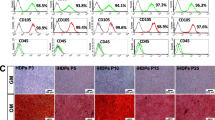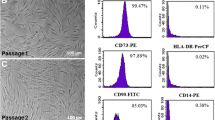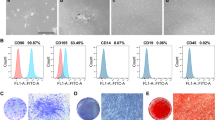Abstract
Similar to the mesenchymal stem cells (MSCs), dental pulp stem cells (DPSCs) also have pluripotent differentiation characteristic and may be more ideal for tissue regeneration, especially in tooth regeneration engineering. However, bacterial infection may be a powerful obstacle. Berberine (BBR), known with antibacterial effects, was recently found to play functions in bone formation through promoting osteogenic differentiation from pluripotent stem cells. However, whether BBR also function in DPSCs osteogenic differentiation has not yet been reported. Primary DPSCs were isolated from dental pulp tissues extracted from human impacted mandibular third molars, and identified by flow cytometry for cell surface antigen molecules. A dexamethasone osteogenic medium was used to induce DPSCs osteogenic differentiation. BBR (1 μM and 5 μM) was pre-added to into medium, and then cell proliferation, spheroid formation and osteogenic differentiation capacities of DPSCs were analyzed, as well as the underlying molecules modulation mechanism. Flow cytometry identified that CD44, CD90, CD81 and CD105 positively expressed in the isolated hDPSCs, with CD34 and CD45 negetively expressed. BBR enhanced the cell proliferation of hDPSCs in a dose-dependent pattern, and promoted dexamethasone-induced osteogenic differentiation via enhancing Runx2 transcription factor activity followed by upregulating osteogenesis markers expression, whereas the adipogenic differentiation of hDPSCs was suppressed dramatically by BBR. The EGFR and MAPK pathways were activated by BBR, and inhibitors for these pathways significantly suppressed the osteogenic differentiation promotion of BBR. These results have revealed a novel mechanism that berberine might promote hDPSCs osteogenic differentiation through activating EGFR-MAPK-Runx2 signaling pathways.





Similar content being viewed by others
References
Gronthos S, Mankani M, Brahim J, Robey PG, Shi S (2000) Postnatal human dental pulp stem cells (Dpscs) in vitro and in vivo. Proc Natl Acad Sci U S A 97:13625–13630
Valverde Y, Narayanan R, Alapati SB, Chmilewsky F, Huang CC, Ravindran S, Chung SH (2018) Poly(adenosine phosphate ribose) polymerase 1 inhibition enhances brain-derived neurotrophic factor secretion in dental pulp stem cell-derived Odontoblastlike cells. J Endod 44:1121–1125
Iohara K, Nakashima M, Ito M, Ishikawa M, Nakasima A, Akamine A (2004) Dentin regeneration by dental pulp stem cell therapy with recombinant human bone morphogenetic protein 2. J Dent Res 83:590–595
Itoh Y, Sasaki JI, Hashimoto M, Katata C, Hayashi M, Imazato S (2018) Pulp regeneration by 3-dimensional dental pulp stem cell constructs. J Dent Res 97:1137–1143
El-Backly RM, Massoud AG, El-Badry AM, Sherif RA, Marei MK (2008) Regeneration of dentine/pulp-like tissue using a dental pulp stem cell/poly(lactic-co-glycolic) acid scaffold construct in New Zealand white rabbits. Aust Endod J 34:52–67
de Souza PV, Alves FB, Costa Ayub CL, de Miranda Soares MA, Gomes JR (2013) Human immature dental pulp stem cells (Hidpscs), their application to cell therapy and bioengineering: an analysis by systematic revision of the last decade of literature. Anat Rec (Hoboken) 296:1923–1928
Chopra RN, Dikshit BB, Chowhan JS (1932) Berberine and Berberine-containing plants in pharmacology and therapeutics. Ind Med Gaz 67:194–197
Habtemariam S (2016) Berberine and inflammatory bowel disease: a concise review. Pharmacol Res 113:592–599
Xie Q, Johnson BR, Wenckus CS, Fayad MI, Wu CD (2012) Efficacy of Berberine, an antimicrobial plant alkaloid, as an endodontic Irrigant against a mixed-culture biofilm in an in vitro tooth model. J Endod 38:1114–1117
Wei P, Jiao L, Qin LP, Yan F, Han T, Zhang QY (2009) Effects of Berberine on differentiation and bone resorption of osteoclasts derived from rat bone marrow cells. Zhong Xi Yi Jie He Xue Bao 7:342–348
Lee HW, Suh JH, Kim HN, Kim AY, Park SY, Shin CS, Choi JY, Kim JB (2008) Berberine promotes osteoblast differentiation by Runx2 activation with P38 Mapk. J Bone Miner Res 23:1227–1237
Tao K, Xiao D, Weng J, Xiong A, Kang B, Zeng H (2016) Berberine promotes bone marrow-derived mesenchymal stem cells osteogenic differentiation via canonical Wnt/Beta-catenin signaling pathway. Toxicol Lett 240:68–80
Liu J, Zhao X, Pei D, Sun G, Li Y, Zhu C, Qiang C, Sun J, Shi J, Dong Y, Gou J, Wang S, Li A (2018) The promotion function of Berberine for osteogenic differentiation of human periodontal ligament stem cells via Erk-Fos pathway mediated by Egfr. Sci Rep 8:2848
Chang Y (1959) Effectiveness of Berberine in bacillary dysentery. Zhonghua Nei Ke Za Zhi 7:741–743
Dong H, Zhao Y, Zhao L, Lu F (2013) The effects of Berberine on blood lipids: a systemic review and meta-analysis of randomized controlled trials. Planta Med 79:437–446
Ma X, Chen Z, Wang L, Wang G, Wang Z, Dong X, Wen B, Zhang Z (2018) The pathogenesis of diabetes mellitus by oxidative stress and inflammation: its inhibition by Berberine. Front Pharmacol 9:782
Pang B, Zhao LH, Zhou Q, Zhao TY, Wang H, Gu CJ, Tong XL (2015) Application of Berberine on treating type 2 diabetes mellitus. Int J Endocrinol 2015:905749
Wu X, Li X, Dang Z, Jia Y (2018) Berberine demonstrates anti-inflammatory properties in helicobacter pylori-infected mice with chronic gastritis by attenuating the Th17 response triggered by the B cell-activating factor. J Cell Biochem 119:5373–5381
Chuang TY, Wu HL, Min J, Diamond M, Azziz R, Chen YH (2017) Berberine regulates the protein expression of multiple tumorigenesis-related genes in hepatocellular carcinoma cell lines. Cancer Cell Int 17:59
Tsang CM, Cheung YC, Lui VW, Yip YL, Zhang G, Lin VW, Cheung KC, Feng Y, Tsao SW (2013) Berberine suppresses Tumorigenicity and growth of nasopharyngeal carcinoma cells by inhibiting Stat3 activation induced by tumor associated fibroblasts. BMC Cancer 13:619
Zhou Y, Tao H, Li Y, Deng M, He B, Xia S, Zhang C, Liu S (2016) Berberine promotes proliferation of sodium nitroprusside-stimulated rat chondrocytes and osteoarthritic rat cartilage via Wnt/Beta-catenin pathway. Eur J Pharmacol 789:109–118
Feng G, Zhang J, Feng X, Wu S, Huang D, Hu J, Zhu S, Song D (2016) Runx2 modified dental pulp stem cells (Dpscs) enhance new bone formation during rapid distraction osteogenesis (do). Differentiation 92:195–203
Ducy P, Zhang R, Geoffroy V, Ridall AL, Karsenty G (1997) Osf2/Cbfa1: a transcriptional activator of osteoblast differentiation. Cell 89:747–754
Artigas N, Urena C, Rodriguez-Carballo E, Rosa JL, Ventura F (2014) Mitogen-activated protein kinase (Mapk)-regulated interactions between Osterix and Runx2 are critical for the transcriptional osteogenic program. J Biol Chem 289:27105–27117
Johnson GL, Lapadat R (2002) Mitogen-activated protein kinase pathways mediated by Erk, Jnk, and P38 protein kinases. Science 298:1911–1912
Lee KS, Hong SH, Bae SC (2002) Both the Smad and P38 Mapk pathways play a crucial role in Runx2 expression following induction by transforming growth factor-Beta and Bone morphogenetic protein. Oncogene 21:7156–7163
Kanno T, Takahashi T, Tsujisawa T, Ariyoshi W, Nishihara T (2007) Mechanical stress-mediated Runx2 activation is dependent on Ras/Erk1/2 Mapk signaling in osteoblasts. J Cell Biochem 101:1266–1277
Ge C, Xiao G, Jiang D, Yang Q, Hatch NE, Roca H, Franceschi RT (2009) Identification and functional characterization of Erk/Mapk phosphorylation sites in the Runx2 transcription factor. J Biol Chem 284:32533–32543
Huang RL, Yuan Y, Tu J, Zou GM, Li Q (2014) Opposing Tnf-alpha/Il-1beta- and bmp-2-activated Mapk signaling pathways converge on Runx2 to regulate bmp-2-induced osteoblastic differentiation. Cell Death Dis 5:e1187
Huang YF, Lin JJ, Lin CH, Su Y, Hung SC (2012) C-Jun N-terminal kinase 1 negatively regulates osteoblastic differentiation induced by Bmp2 via phosphorylation of Runx2 at Ser104. J Bone Miner Res 27:1093–1105
Fujii Y, Kawase-Koga Y, Hojo H, Yano F, Sato M, Chung UI, Ohba S, Chikazu D (2018) Bone regeneration by human dental pulp stem cells using a Helioxanthin derivative and cell-sheet technology. Stem Cell Res Ther 9:24
Acknowledgments
We would like to give our sincere gratitude to the reviewers for their constructive comments.
Funding
This work was supported by Qingdao Medical Science and Technology Guiding Project (No.2017-WJZD125), Qingdao Shinan District Science and Technology Development Fund (No.2016-3-042-YY) and Qingdao Stomatological Hospital Youth Fund Project (No.2018QN01, No.2019QNJJ02).
Author information
Authors and Affiliations
Corresponding author
Ethics declarations
Conflict of Interest
The authors declare that they have no conflict of interest.
Ethical Approval
All procedures performed in studies involving human participants were in accordance with the ethical standards of the institutional and/or national research committee and with the 1964 Helsinki declaration and its later amendments or comparable ethical standards.
Informed Consent
Informed consent was obtained from all individual participants included in the study.
Additional information
Publisher’s Note
Springer Nature remains neutral with regard to jurisdictional claims in published maps and institutional affiliations.
Electronic Supplementary Materials
Figure. S1
The adipogenic differentiation of hDPSCs. Oil red-O staining analysis for the lipid droplets formation in the hDPSCs after 14 days induction by special adipogenic differentiation induction medium (LM) containing 10% FBS, 1 mg/ml insulin, 1 mM dexamethasone, 0.5 mM isobutyl methylxanthine and 100 mM indomethacin. Cells cultured with routine medium (RM) was considered as control. (PNG 371 kb)
High resolution image
(TIF 974 kb)
Figure. S2
The effects of Berberine on the adipogenic differentiation of hDPSCs. hDPSCs were cultured with special adipogenic differentiation induction medium containing 1, 5 μM Berberine or 0.1% DMSO for 14 days, and Oil red-O staining was used to analyzed the lipid droplets formation. (PNG 542 kb)
High resolution image
(TIF 1445 kb)
Rights and permissions
About this article
Cite this article
Xin, BC., Wu, QS., Jin, S. et al. Berberine Promotes Osteogenic Differentiation of Human Dental Pulp Stem Cells Through Activating EGFR-MAPK-Runx2 Pathways. Pathol. Oncol. Res. 26, 1677–1685 (2020). https://doi.org/10.1007/s12253-019-00746-6
Received:
Accepted:
Published:
Issue Date:
DOI: https://doi.org/10.1007/s12253-019-00746-6




